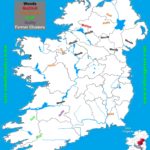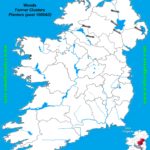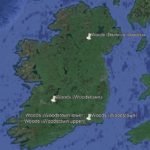Case Studies

Case Study: Ingemar Woods Y-DNA
Pinpointing his Paternal Homelands
By Dr. Tyrone Bowes – 2018-08-03
Introduction
A simple painless commercial ancestral Y chromosome DNA test will potentially provide one with the names of many hundreds of individuals with whom one shares a common male ancestor. But what often perplexes people is how one can match many individuals with different surnames? The answer is quite simple. Roughly 1,000 years ago one’s direct medieval male ancestor, the first for example to call himself ‘Woods’ was living in close proximity to others with whom he was related, but who assumed other surnames. In the 1,000 years since paternally inherited surnames were first adopted there will be many descendants of those individuals some of whom will today undergo commercial ancestral Y-DNA testing. Hence the surnames of one’s medieval ancestor’s neighbors will be revealed in today’s Y-DNA test results.
The subject of this study is based on such a Y-DNA test from the individual Dr. Ingemar Woods, and the objective is to match his Y-DNA with others in the IrishOrigenes database.
Part I: The Woods Surname
Woods is a common surname associated with Great Britain (click here) and Ireland (click here). However, in Ireland Wood can be of multiple origins; Norman (post 1169AD), Plantation origin (post 1600AD) but it may also in some instances be an anglicized form of Gaelic McEnhill, McIlhoyle, Kilmet (which are pretty much extinct in Ireland) but also Quill, Quilty, Kielty, Kielt and McElhill. Wood in Gaelic is Coillte (Coil che).
Since Ireland remained an agrarian society until relatively recently it means 2 things; first, surnames arose in an agrarian society and secondly farmers in Ireland in early census data could still be found farming the lands where their ancestor lived when he first inherited his surname (or where one’s ancestors first settled in Ireland; in the case of Norman and Planters). In addition place names and historical monuments reveal a wealth of information about the people who lived there and one can explore place names and historical monuments to see if there are any associated with the Woods surname. As a rule, the longer a surname has been associated with a location, the better the chances that one will find place names and historical monuments (like tower houses and castles) associated with that surname in that location.
An examination of the location of Catholic farmers (which are pre-Plantation and hence either Norman or Gael) named Woods reveals that they are not scattered uniformly but are found concentrated in specific locations, see attached Woods farmers Ireland image. That map reveals 7 distinct groups of (Norman/Gael) Woods farmers in Ireland. But which are of Gaelic origin, and which are Norman origin? Well, by overlay mapping the farmer locations on a map of permanent Norman settlement (reconstructed based on castle locations and each castles associated Clan/Family click here) one can see that there are 3 groups of Woods (red arrows attached Woods in Norman Ireland image) that lie on/close to areas of permanent Norman settlement. The remaining 4 groups are deep in Gaelic Ulster and bordering Connacht and are most likely anglicized McElhill and Kielty, see attached Woods farmers plus Gaelic surnames image. In addition, I have attached an image showing the location of Protestant (Planter post 1600AD) Woods farmers, see attached Woods Plantation Ireland Farmers image. In summary, there are multiple potential origins of the Wood surname in Ireland, but the DNA results reveal clues as to where one’s Irish Woods originated.
An examination of my Origenes databases reveals only a few townlands that are associated with the Woods surname, those in the south are of Norman origin while the solitary townland in Ulster is a reference to a Planter named Woods, see attached Woods townland Ireland image.
Part II: The Science of Surnames
Scientists (at Trinity College, Dublin, Ireland) studying surnames and relatedness among males discovered that surnames typically had a single founding ancestor; the ‘surname-Adam’ (as in Adam and Eve) who was literally the first male to take for example the ‘Woods’ surname. The surname-Adam typically lived approximately 1,000 years ago when paternally inherited surnames became common within Britain and Ireland. Scientists have also discovered that after 1,000 years there is a 50% chance that one is directly descended from one’s surname-Adam, the other 50% of males will have acquired their surname as a result of non-paternal events like adoptions or via the maternal transfer of the surname that have occurred since the surname first appeared (so anytime within the last 1,000 years, the 50% rule has remained remarkably consistent for each surname). So how does one determine which 50% one belongs to? If one matches others with the same (or similar sounding) surname upon commercial ancestral Y-DNA testing who have tested independently, then one typically belongs to the 50% of males who are directly descended from their surname-Adam. Upon Y-DNA testing, Ingemar Woods did match others named Woods which indicates that he is directly descended from a Woods-Adam. BUT! As I demonstrated in part I Woods is a very common surname, and hence 1,000 years ago there may have been many Woods-Adams living throughout Great Britain and Ireland.
Since surnames arose among what were essentially tribal groups of related males living in a specific location (and since surnames still concentrate in the area they first appeared); the other surnames revealed upon Y-DNA testing act as a snapshot of Ingemar’s ancestral neighbors/relatives 1,000 years ago, and should therefore reveal where your direct male ancestor lived 1,000 years ago. For example, a Woods from Ayrshire in Scotland will upon Y-DNA testing be a Y-DNA genetic match to individuals with surnames like Crawford, Ferguson and Cathcart; surnames associated with Southwest Scotland. In contrast a person whose Woods surname is an anglicized version of McElhill will upon Y-DNA testing be a genetic match to males with surnames like McGuire, McGrath, Tracey and Boylan; surnames associated with Fermanagh in Southwest Ulster. Hence, it is one’s Y-DNA genetic relatives that will reveal clues as to one’s paternal origin. One can read more about the science of surnames here and here.
Part III: Y-DNA Genetic Matches
With regards to any Y-DNA results, its important to remember 2 things: DNA does not lie; males who appear among one’s Y-DNA (STR) results share a common male ancestor with you. It is merely a question of when that shared male ancestor lived (as a rule the more Y-DNA markers 2 males share the more recent that shared paternal ancestor lived). For a time frame to a shared paternal ancestor based on commercial YDNA STR results click here. Also keep in mind that the STRs examined by the Y-DNA67 test are far more susceptible to replication and deletion per generation, and hence that is why one sees variability in the numbers of shared markers even among genetic matches that for example share the Woods surname.

The closest surname matches in Ingemar’s Y-DNA results (at the 67 and 37 marker levels) are NOT RANDOM! Firstly, there are multiple individuals named Woods (some of whom tested independently) which tells me that the test subject is descend from a Woods-Adam, see attached Woods 67 Marker Matches image. In addition, at least one Woods genetic relative records their earliest Woods in Ireland and the singular close match to a Fitzsimmons (which is associated overwhelmingly with Ireland) would support a most recent link with Ireland.
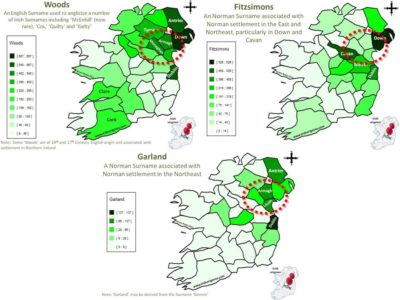
The genetic distance at the 67 marker level indicates that the Fitzsimmons individuals ancestor was originally a Woods and his association with the Fitzsimmons surname is the result of a non-paternal event between a Woods and Fitzsimmons that occurred within Ireland. There is also evidence of another non-paternal event involving the ‘Garland’ surname, highlighted in green font attached Woods 67 Marker Matches image). Garland caught my eye as it is associated with Ireland where it is an anglicized version of Gaelic McGartland. So, what the Y-DNA matches reveal to me is that your Woods ancestors lived in an area of Ireland where they formed relationships with Norman Fitzsimmons and Gaelic McGartlands/Garlands. Hence I can examine where those surnames occur together in Ireland to reveal a common location.
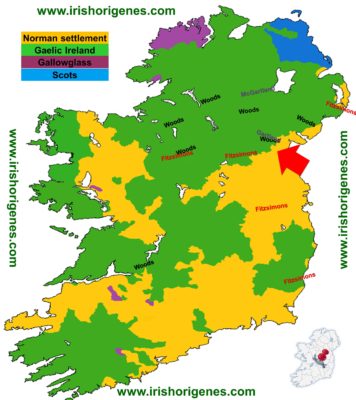
A quick look at Surname Distribution Maps of Woods, Fitzsimmons and Garland in 1911 reveals a common area on the Southeast borderlands of Ulster and Leinster. (See the red broken circle in the attached Woods Fitzsimons Garland SDM image). As mentioned, farmers with each surname still concentrate in the area where one’s ancestors first settled, and hence overlaying Woods, Fitzsimons and Gartland/McGartland farmer clusters on a map of permanent Norman settlement reveals only one area where those surnames occur together. (See the red arrow on the attached Woods Fitzsimons Garland Norman Ireland Overlay image.)

A closer examination where precisely farmers named Woods, Fitzsimons/Fitzsimmons and Gartland/Garland are found together in 1901 reveals them in closest proximity to one another in the farmland that lies midway between Ardee and Carrickmacross on the Louth and Monaghan borderlands, see attached Carrickmacrosss and Ardee image. That is the area where your most recent Woods ancestors as revealed by the Y-DNA matches lived within Ireland. It is that area one should focus on when attempting to reconnect an ancestral paper trail. This area is located immediately on the northern borderlands between what would have been the Gaelic world of Ulster and the Norman world of the Pale where Gael and Gall (foreigners) mixed as evident in your Y-DNA matches. The maps I have made will detail the surnames associated with that location; and so as more people test more and more of the surnames associated with that area will appear among your closest Y-DNA matches (my maps help identify those surnames).
When there are few Y-DNA genetic matches, I will often explore the autosomal DNA results for additional clues that would support the link to the area that has emerged in the Y-DNA.
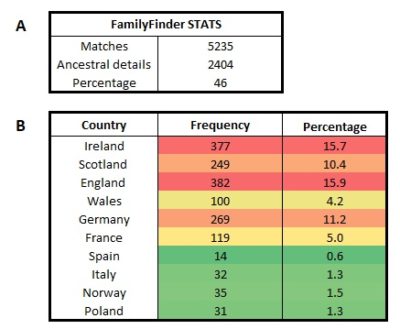
Part IV: Family Finder Stats
Family Finder is an autosomal DNA test that explores shared ancestry over all your ancestral lines over the last 150-200 years. Basically the surnames and locations revealed by some of your Family Finder matches will be the result of marriages and relationships formed while they lived in Ireland. As with every DNA test the results are not random and a quick analysis of the Family Finder results can easily demonstrate that!
Ingemar has 5,235 genetic relatives in Family Finder (as of July 2018), BUT only 2,404 of whom reveal any kind of detail regards their ancestors (surname and/or ancestral locations), see panel A Woods FamilyFinder stats image. Thats 46% which is quite good (compared to other DNA testing companies). The surnames and locations revealed by these relatives are NOT RANDOM!… certain Countries stand out. For example when I blast/search those 2,404 matches for references to England, Scotland, Wales and Ireland together with a sample of Mainland European Countries one can see that Ireland stands out (see panel B, Woods FamilyFinder stats image). One can see that 15% of Ingemar’s 2,404 matches record ancestral links with Ireland. That’s a strong signal and an indication of ancestral connections with Ireland during the 150-200 time frame (keep in mind there’s a 10 fold difference in the population of England and Ireland). BUT even if Ingemar’s Woods ancestors had left Ireland earlier than the 150-200 year time-frame … some of Ingemar’s genetic relatives will have ancestral paper trails that stretch beyond that period, and although the signal may be weaker there may still be evidence of the Woods ancestral links with the Cavan and Louth borderlands.
Part V: Family Finder Stats and Irish Counties
Ireland is divided into 32 Counties and I can blast search those counties in the Family Finder results to identify specific areas within Ireland that are associated with one’s Irish ancestors. The challenge then is to link an ancestral surname with an emerging area. That can be easy with surnames like Sullivan or McCarthy which are overwhelmingly associated with a single location within Southwest Ireland, but more challenging with common surnames like Kelly or Murphy.
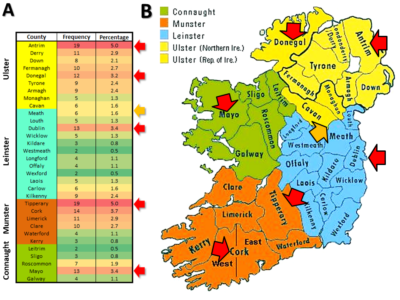
When I blast search Ingemar’s autosomal results for Irish Counties a number of areas emerge, some are no surprise; Antrim which is (looking at ancestral Antrim surnames) due to the Ulster Scots migration to the New World (post 1700s), but also Donegal, Mayo and Cork; reflecting more recent Catholic Irish migration (post 1840s). Interestingly there is a strong signal from Tipperary/Kilkenny which I don’t normally see but to me is an area most notably associated with Norman colonization, as is the area surrounding Dublin (the Pale) which also gives a good signal, but is also probably reflective of more recent migration to Dublin City, see red arrows attached Irish County Stats image. The Family Finder results also revealed a weak signal with the Cavan/Meath borderlands, see yellow arrow attached Irish County Stats image. But its a weak signal which is what one would expect if the Woods had departed before the 150-200 year time frame explore in Family Finder.
There’s not much more I can determine from the Family Finder results, signal is too weak and too few ancestral surnames and locations revealed to allow a pattern to emerge. One thing I have found is that communities tend to migrate together, and hence one may find that the same surnames from an area of Ireland keep turning up in the area they first settle in the Americas! For example, the Scots border Clans like the Armstrongs, Elliotts, Grahams, Johnstones and Irvings all left the borders area of Scotland and colonized Fermanagh in Ulster, in the new world those communities can often also be found together in early census data.



